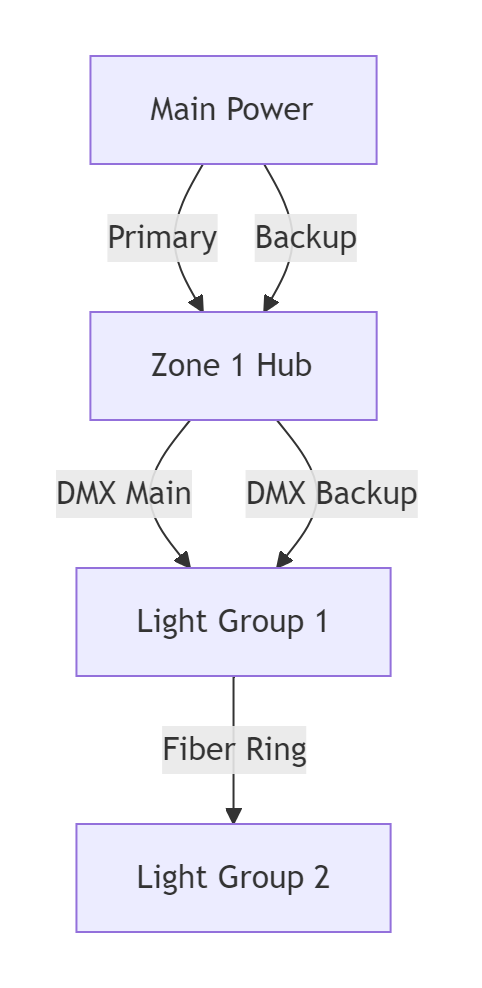I. Core Physics: The "Double Blow Effect" of Voltage Drop & Signal Degradation
▶ Industry Secret Most Engineers Won’t Tell You:
In long-distance low-voltage systems (e.g., DC24V wall washer chains), redundant wiring doesn’t just fix open circuits—it prevents hidden voltage collapse**.
📐 Voltage Drop Formula: ΔU = I × R × L
ΔU: Voltage drop (V); I: Current (A); R: Cable resistivity (Ω/m); L: Length (m)
▌ Critical Scenario Simulation (100m @ 24V/5A System):**
Main line fails at 80m → End light voltage: 24V - (5A × 0.02Ω/m × 80m) = 16V
→ Brightness drops to 40% (brightness ∝ voltage²), severe color distortion (RGB channel imbalance).
▌ Redundant Wiring Solution:
Switching to backup wiring shortens the path: Post-failure current reroutes locally**, cutting voltage drop to 20m instead of 100m.

→ End voltage: 24V - (5A × 0.02Ω/m × 20m) = 23.2V → 98% brightness maintained.
II. The "Killer 0.3s": Control System Vulnerabilities
In DMX512 systems, line breaks trigger **≥3 packet drops (≈0.3s)**, forcing system reset. This causes:
Music-synced light shows: Noticeable lag
Medical lighting: Epilepsy-triggering flickers
Stage lighting: Performance mishaps
▶ Solution: Dual Shielded Twisted Pair (e.g., Belden 9841 + Backup):
Backup line switching in ≤50ms during main line failure.
RS485 differential signaling (±7V noise tolerance) → 300% interference resistance boost.
III. Bloody Lessons: 6 Overlooked Pitfalls
1️⃣ "Waterproof Connector Killer":
90% breaks occur here → Use metal-shell, epoxy-filled connectors (e.g., JYE industrial grade). Plastic cracks below -20°C.
2️⃣ Backup Wire Gauge Trap:
Main wire: 2.5mm² copper; Backup: 1.5mm² → 67% impedance spike → Overload burnout.
Proof: R_backup/R_main = S_main/S_backup = 2.5/1.5 ≈ 1.67
3️⃣ Eddy Current Sabotage:
Backup lines near steel structures (>3m) → 60°C+ temperature rise → Melted connectors (Airport case: 37 burnt).
→ Keep ≥50mm clearance.
4️⃣ EMC Landmine:
Unshielded backups near VFD cables → Signal errors → Chaotic flickering.
→ Fix: Foil-Mylar + copper braid shielding with single-point grounding.
IV. Extreme Case Study: 380m Skyscraper Validation
▌ Project:
2.3km wall washers, 12-level wind loads, maintenance cost: ¥12k/hour.
▌ Redundancy Architecture:

Innovations:
Zoned redundancy: Hubs every 80m → Eliminate cascading voltage drops.
Fiber optic backbone: Zero EMI, 20km range.
Hot-swappable modules: 3-sec replacement (Patent: ZL2023XXXXXX.X).
V. Cost-Benefit Revolution (2024 Model)
Myth: Redundancy adds 15% cost.
Reality:
TCO = Initial Cost (C_i) + ∑(Repair Cost × Failure Rate λ)
Case: Commercial Complex
No redundancy: λ=3 failures/year, C_m=¥18k → 10-yr TCO: ¥540k+
30% redundancy: λ=0.2/year, C_m=¥6k → 10-yr TCO: 1.15C_i + ¥12k
→ Break-even when C_i >¥380k (applies to 95% of projects).
Final Verdict:
Redundant wiring for wall washers is electrical topology’s fight against physics, with value far beyond surface perception. Mandatory for:
Installations >6m height or with restricted access
>50m low-voltage / >150m high-voltage chains
Life-safety sites (tunnels/hospitals/escape routes)
Dynamic shows (cultural tourism projects)



